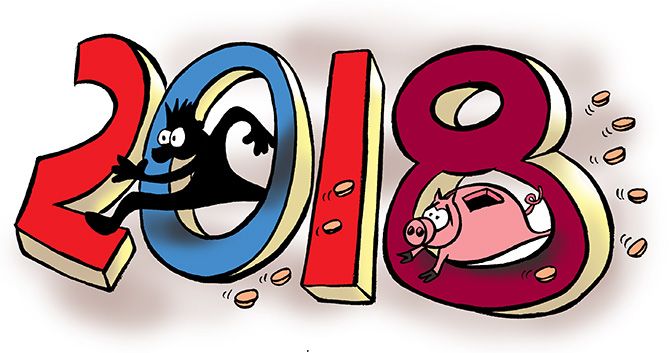While selling started in April, it has intensified this month, with FPIs pulling out $1.1 billion and $2.5 billion from equities and debt market, respectively
Illustration: Uttam Ghosh/Rediff.com

Foreign portfolio investors (FPIs) have dumped domestic bonds and equities worth nearly $7 billion (~441 billion) since April.
The pullback comes amid the greenback’s ascendance against most global currencies and the 10-year US Treasury hitting the dreaded 3 per cent mark.
The sell-off has roiled the Indian financial markets, with the 10-year government security inching towards 8 per cent, the rupee dropping to a 16-month low of 68 against the dollar, and stocks seeing across-the-board correction.
While selling started in April, it has intensified this month, with FPIs pulling out $1.1 billion and $2.5 billion from equities and the debt market, respectively.
On a year-to-date (YTD) basis, FPIs’ investment in stocks is on the verge of turning negative, while in the debt segment, the outflows are nearing $5 billion.
“Lots of uncertainty and concerns internationally are making investors risk-averse. They are moving into the safety of US dollar and bonds,” says U R Bhat, managing director, Dalton Capital Advisors.
The dollar index, a gauge for the performance of the US dollar against six major currencies, has gained nearly 6 per cent since April to 94.25.
The gain has been supported by inflation and the economic outlook for the US and the rate hike increase forecast of the Federal Reserve.
“Anything denominated in greenback looks suddenly a lot more enticing. That raises risk for anyone pondering investments in emerging markets (EMs),” says Frederic Neumann, co-head of Asian economics research, HSBC.
Foreign capital outflows from the domestic markets are unlikely to stem in a hurry as economists see the Fed hiking rates at its meeting next month.
Experts say the US central bank is turning more hawkish as it shifts its policy stance from one that needed it to stimulate growth to one that requires it to prevent the economy from overheating.
“Stocks have had a good run in the past one year. Investors are taking profits and waiting for better times to reinvest,” says Bhat.
India is not the only equity market where FPIs have taken money off the table. Thailand and South Africa have seen higher net outflows in May.
YTD, there are several EMs staring at huge capital outflows.
In fact, India’s YTD tally worsens if one ignored the $700 million inflows seen on March 13 on account of a $1.2-billion share sale in Tata Consultancy Services by promoter Tata Sons.
In the past decade, India has had only two years - 2008 and 2011 - when FPI flows have been negative in the equity segment.
Calendar 2018 could yet be another year to record negative flows - and one of the rare years when both the equity and the debt segment see outflows together.
“Strong foreign flows have been bedrock of each phase of strong economic and stock market cycle in India. These flows have either come in the form of foreign direct investment, FPI equity or FPI debt in each of the previous cycle. These flows appear to have tapered and may continue to remain shallow in the short term,” says Sahil Kapoor, chief market strategist, Edelweiss.
“Elevated bond yields, EM currency weakness, and deteriorating current account are likely to keep Indian markets under check,” he adds.
Besides capital outflows singeing financial markets, they also pose a headache for policymakers, especially the Reserve Bank of India (RBI).
Economist at HSBC and several other banks have changed their call on RBI policy action. HSBC now expects the central bank to hike rates twice this year instead of putting them on hold.
“From a domestic perspective, tightening may not necessarily be warranted, but the external turn raises pressure,” says Neumann.
Losses on bond investments
As yields rise, and prices of bonds fall, these FPIs are seeing their portfolio value eroding. In India, the 10-year bond yields are nearing 8 per cent now, from about 6.5 per cent seven months ago.
In 2018, FPIs have incurred both interest rate risk and currency risks on their investments.
“The large FPI flows in 2017 was associated with peak of rupee, and bottom-of-interest rate in India and globally. Now the entire contour has reversed with pressure on EM currencies and rising rates, but more cause for concern is strengthening dollar and rising oil price at the same time,” says Soumyajit Niyogi, associate director at India Ratings and Research.
Serious foreign investors enter the country on a fully hedged basis, which adds to 4-5 percentage points in interest rate. A stable currency since 2013 was eliminating the need for this hedging.
This leads to the speculator class of investors that never hedges. Even as the central bank saw this short-term yield chasing investors suspiciously, it has recently warmed up to such flows to stem the outflow.
“With the change in dynamics, there is no money to be made for someone borrowing in US dollars on a fully hedge basis,” says Bhat.













 © 2025
© 2025